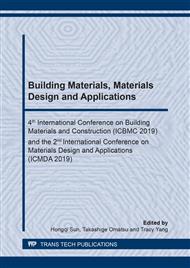[1]
Morin, V. Cohen Tenoudji, F., Fyeylesoufi, A.and Richard, P: Superplasticizer effects on setting and structuration mechanisms of ultra-high-performance concrete. Cement and concrete research, 31(2001), pp.63-71.
DOI: 10.1016/s0008-8846(00)00428-2
Google Scholar
[2]
Pierre-Claude Aitcin and Adam Neville: High-performance concrete. Concrete International, 15 (1) (1993), pp.21-26.
Google Scholar
[3]
Gintautas, Skripkiiinas., Zymantas, Rudzionis. and Vitoldas, Vaitkevicius: Complex admixtures for high strength concrete. Journal of civil engineering and management, 8(4) (2002), pp.276-280.
Google Scholar
[4]
A. Narender Reddy and T. Meena: A study on compressive behaviour of ternary blended concrete incorporating alccofine. Materials today proceedings 5(5) (2018), p.11356 – 11363.
DOI: 10.1016/j.matpr.2018.02.102
Google Scholar
[5]
Parveen, Dhirendra Singhal, M. Talha Junaid, Bharat Bhushan Jindal and Ankur Mehta: Experimental study on geopolymer concrete prepared using high-silica RHA incorporating alccofine. Construction and Building Materials, 180 (2018), p.98–307.
DOI: 10.1016/j.conbuildmat.2018.05.286
Google Scholar
[6]
Saxena, S.K., Kumar, M., Singh, N.B.: Effect of Alccofine powder on the properties of Pond fly ash based Geopolymer mortar under different conditions. Environmental Technology & Innovation, S2352-1864(17) (2018), pp.30269-9.
DOI: 10.1016/j.eti.2017.12.010
Google Scholar
[7]
Bharat Bhushan Jindal, Dhirendra Singhal, Sanjay K. Sharma and Parveen: Suitability of Ambient-Cured Alccofine added Low-Calcium Fly Ash-based Geopolymer Concrete. Indian Journal of Science and Technology, 10(12) (2017).
DOI: 10.17485/ijst/2017/v10i12/110428
Google Scholar
[8]
Parveen, Dhirendra Singhal and Bharat Bhushan Jindal, in: Experimental study on geopolymer concrete prepared using high-silica RHA incorporating alccofine. Advances in Concrete Construction, 5(4) (2017), pp.345-358.
DOI: 10.1166/asem.2017.1993
Google Scholar
[9]
Rajesh Kumar S, Amiya K Samanta and Dilip K. Singha Roy, in: An experimental study on the mechanical properties of alccofine based high-grade concrete. International Journal of Multidisciplinary Research and Development, 2(10) (2015), pp.218-224.
Google Scholar
[10]
J. Alexandre Bogas, M. Glória Gomes, Augusto Gomes: Compressive strength evaluation of structural lightweight concrete by non-destructive ultrasonic pulse velocity method, Ultrasonics, 50(5) (2013), pp.962-972.
DOI: 10.1016/j.ultras.2012.12.012
Google Scholar
[11]
Mohd Shariq, Jagdish Prasad, Amjad Masood: Studies in ultrasonic pulse velocity of concrete containing GGBFS, Construction and Building Materials, 40 (2013), pp.944-950.
DOI: 10.1016/j.conbuildmat.2012.11.070
Google Scholar
[12]
IS 516 (1959): Method of Tests for Strength of Concrete [CED 2: Cement and Concrete], amendment number 1 and 2.
Google Scholar
[13]
IS 13311-1 (1992): Method of Non-destructive testing of concret, Part 1: Ultrasonic pulse velocity [CED 2: Cement and Concrete].
Google Scholar


